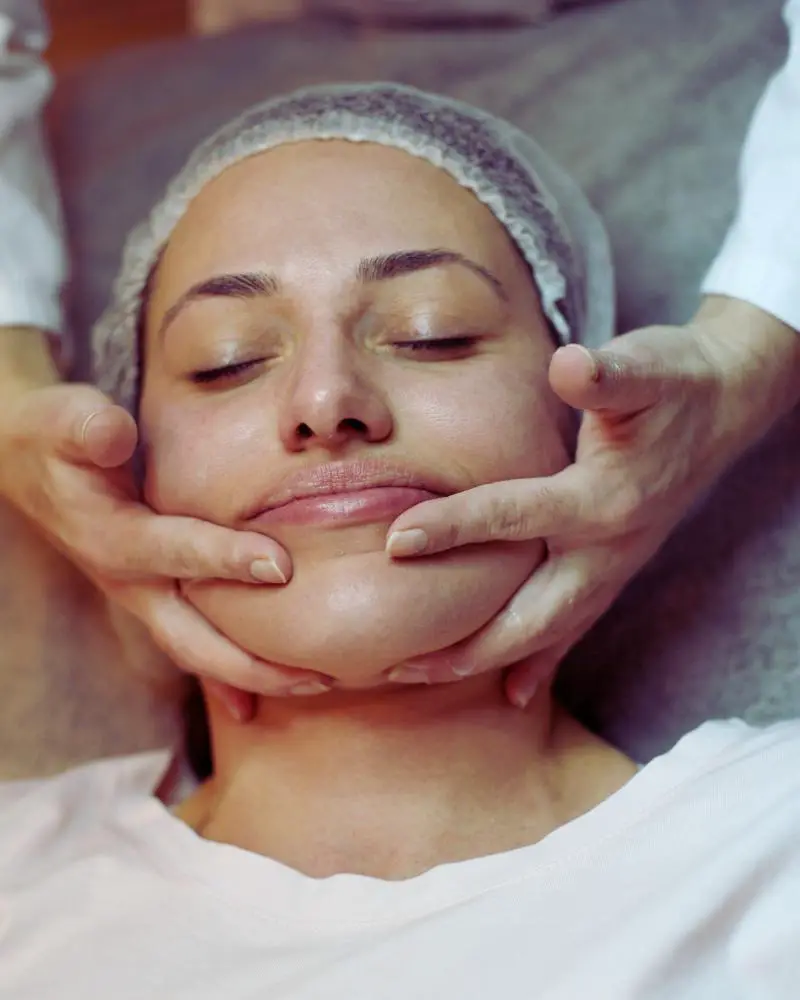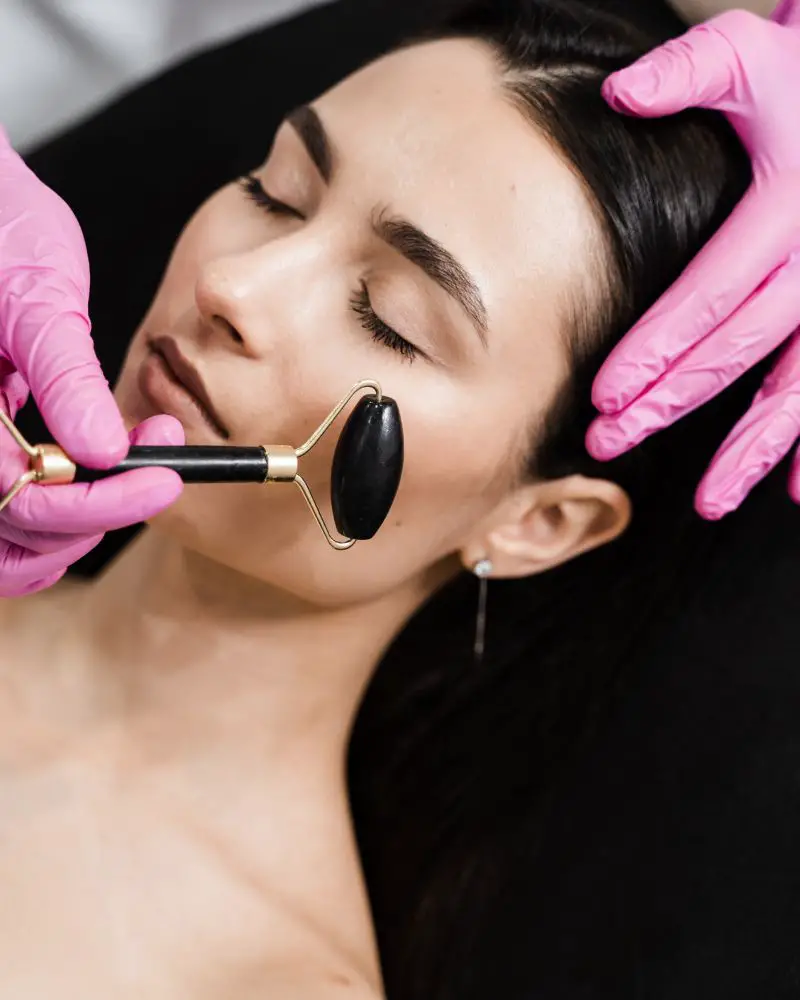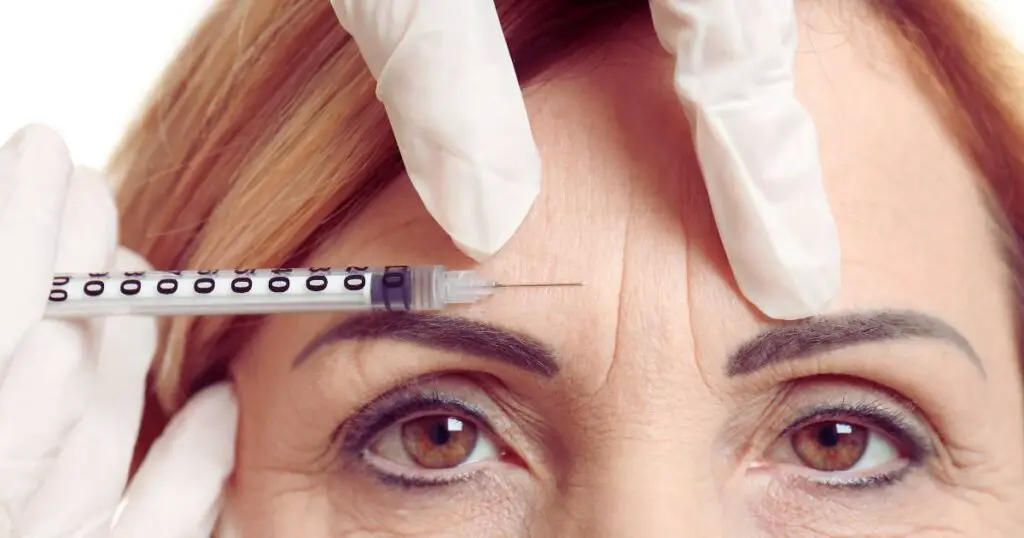As an Amazon affiliate, I may earn from qualifying purchases. Please read our Disclaimer and Privacy Policy.
Can you get a massage after botox injections?
Botox injections are a popular treatment for reducing the appearance of wrinkles and fine lines. The procedure can offer impressive result, but it’s important to follow specific aftercare instructions.
Getting a facial massage too soon after a botox procedure could spread the botulinum toxin to unintended areas. If this happens, you may experience muscle spasms or drooping facial features.
A facial massage can also increase the risk of bruising and other adverse reactions.
Whether or not you can get a massafe after botox depends on the type of massage you plan to get. Lying face down on a massage table is not recommended. Neither is a deep tissue massage.
Keep reading to find out when you can safely get a deep tissue massage after botox, possible side effects of botox injections, and the best aftercare for optimal results.
Disclaimer:
This blog post is not designed to take the place of medical advice. Please don’t consider this your only source of reference when deciding whether to get botox injections, or whether it’s safe to get a massage after botox. Always consult a qualified healthcare provider first.
Understanding the Effects of Botulinum Toxin Injections
Botox, a diluted amount of toxin derived from the bacterium Clostridium botulinum, is widely used for cosmetic purposes.
It works by temporarily paralyzing specific muscles, reducing muscle movement that causes wrinkles like crow’s feet and frown lines. The results of your Botox treatment can last several months, but to achieve longer-lasting results, following the proper aftercare is crucial.
For more information, read Botox Injections as published by the Mayo Clinic.
Why Aftercare Is Crucial
Aftercare tips are vital to ensure that the Botox injections work effectively and reduce the appearance of wrinkles without causing adverse effects.
Activities that increase blood pressure or affect blood flow, such as vigorous exercise or facial massage, should be avoided for a period after the procedure.
Avoid Touching The Treated Area
Don’t touch, rub, or massage the treated area for at least 4 to 6 hours after treament. This is because it can cause botox to spread to unintended areas. This could lead to unwanted side effects including drooping eyelids or muscle weakness.
Stay Upright
It’s important to remain upright for at least 4 to 6 hours after the procedures.
Remaining upright helps prevent the Botox from migrating to other areas of the face. Avoid lying down or bending over excessively.
Avoid Strenuous Exercise
Strenuous physical activity can increase blood flow and heart rate, which may cause the Botox to move away from the targeted muscles, potentially reducing its effectiveness.
Avoid exercise for at least 24 hours after botox injection skin treatment.
Avoid Facial Massage After Botox
If you’re wondering if you can get a massage after botox, the answer is no. Avoid facial massages, chemical peels, microdermabrasion, and any other facial treatments for between 24 and 48 hours after botox injections.
Avoid Facial Treatments After Botox
As mentioned above, it’s important to avoid facial treatments right after botox. Refrain from any type of facial skin treatments for 24 to 48 hours.

No Alcohol Consumption
Alcohol thins the blood and increases the risk of bruising at the injection sites. It’s best to avoid alcohol for 24 hours before and after the botox injection.
Avoid Hot Showers, Saunas, Hot Tubs, or Direct Sun
Heat increases blood flow and can potentially cause the botox to spread away from the injection site. Avoid sources of heat for between 24 and 48 hours after botox treatment.
No Lying Face Down
Avoid lying face down, especially on a massage table or otherwise, for the first 24 to 48 hours post botox. The reason is because it can put pressure on the treated area, risking botox displacement.
Avoid Strenuous Activities
Strenuous exercise or activities that significantly raise your heart rate, such as physical activity or excessive sweating, should be avoided for the first 24 hours. These activities can increase blood pressure, potentially affecting the results of the Botox injections.
If you’re curious about the many types of physical therapy to avoid right after botox, read: 35 Competitive Sports for Adults Over 50.
Avoid Blood Thinners
If you are on prescribed blood thinners, getting Botox treatments requires careful consideration and consultation with your healthcare provider.
Blood thinners, such as warfarin, aspirin, or other anticoagulants, can increase the likelihood of bruising and bleeding at the injection sites. Since Botox involves using a needle, the risk of these side effects is higher for individuals on blood thinners.
Consult With Your Healthcare Provider
Although Botox can give impressive results, it’s not safe for everyone.
It’s crucial to consult your prescribing doctor and botox provider before having treatments. They will assess the risks and determine whether it is safe for you based on your medical history and current medication.
If you’re taking blood thinners, and the risk of bruising or bleeding is considered high, your healthcare provider might suggest alternative cosmetic treatments.
Alternative treatments could include the following:
- Dermal fillers
- Microneedling
- Chemical Peels
- Radiofrequency Therapy
- Ultrasound Therapy
- Platelet-Rich Plasma Therapy
- Topical Treatments
- Hydrafacial Treatment
If you’re interested in getting botox instead of alternative treatments like these, read: 5 Undeniable Benefits of Botox Injections
Tips for Choosing and Discussing Alternatives
Always consult with your health professional to discuss the safest options for you. Be upfront about your use of blood thinners so that your practitioner can take appropriate precautions and tailer the treatment to your needs.
As always, be sure to follow aftercare instructions, including avoiding massage after botox.
Can You Get a Facial Massage After Botox?
For best results, getting a facial massage after botox is not advised. Generally speaking, you should wait between 24 and 48 hours before lying face down.
The Risks of a Post-Botox Massage
Getting a facial massage too soon after your Botox procedure can interfere with the treatment’s effectiveness.
Injection Site and Treated Area
Massaging the injection site can cause the botulinum toxin to spread to unintended areas. This may result in unwanted effects, such as muscle spasms or drooping in areas not meant to be treated.
Increased Risk of Bruising
Massaging the treated area can increase blood flow, which raises the risk of bruising and swelling. This can also lead to a longer recovery time.
Adverse Effects on Botox Results
Pressure applied to the treated area can lead to the toxin affecting specific muscles it wasn’t intended for, potentially leading to adverse reactions or suboptimal results.
When Is It Safe to Get a Massage After Botox?
While massage therapy can generally be resumed after a short period, it’s recommended to wait at least 24-48 hours before any type of facial massage.
Waiting allows the Botox to settle into the targeted muscles and reduces the likelihood of the toxin migrating to unintended areas.
13 Side Effects That Could Happen From Getting a Massage After Botox
Botox injections are generally safe and well-tolerated, but like any medical procedure, they can come with potential side effects.
The following side effects may occur whether you have a massage after botox or not. The key to avoiding some of these side-effects is to follow the post-care advice of your healthcare provider.
That said, getting a facial massage right after botox can move the toxin to unwanted areas of the face.
This can negatively affect certain facial muscles and cause bruising around the affected area.
The following are 13 side-effects that could happen after botox treatments.
1 .Bruising
Bruising at the injection site is common.
To prevent bruising, avoid blood thinners, alcohol, and other things (like massage after botox) that can increase the risk of bruising.
2. Swelling
Swelling around the injection site may occur. Applying a cold compress can help reduce swelling.
3. Redness
The skin around the injection site may appear red for a short period. It usually subsides on its own within a hours to a day.
4. Headache
Mild headache can occur after the procedure. It’s usually temporary and can be managed with over-the-counter pain relievers. Consulter your health provider is the headache persists.
5. Nausea
Some people may experience nausea after botox injections. This is less common and typically resolves quickly.
6. Drooping Eyelids
Botox can sometimes cause temporary drooping of the eyelids. This may happen if the toxin spreads from the intended injection site (as it might if you have massage after botox).
If this does happen, it usually resolves within a few weeks. To reduce the risk, make sure you are in the hands of experienced professionals.
7. Uneven Results
In some cases, botox may cause asymmetry or uneven muscle relaxation. This can often be corrected with follow-up treatments or adjustments by your provider.
8. Temporary Muscle Weakness
The treated muscles might experience temporary weakness or reduced movement. This is typically expected and resolves as the Botox effect wears off.
9. Flu-Like Symptoms
Some people report feeling mild flu-like symptoms after the procedure. These symptoms are generally short-lived and should resolve on their own.
10. Dry Mouth or Difficulty Swallowing
Rarely, Botox injections in areas near the mouth or throat can cause these symptoms. If this happens, discuss the symptoms with your provider.
11. Itching or Rash
Some people may develop mild itching or a rash at the injection site. This is usually temporary and can be managed with over-the-counter antihistamines.
12. Allergic Reactions
Although rare, some people may experience a severe allergic reaction to botox. If you have a history of allergies or have ever experienced anaphylaxis, be sure to tell your provider.
13. Eye Dryness or Irritation
Botox may cause dryness or irritation when injected near the eyes. This is usually temporary and should improve with time.
For information on botox injections gone wrong, read Forehead Botox Gone Wrong: Signs of Bad Injections and How to Avoid It by Newbeauty.com.

When to Resume Normal Activities
You can typically resume normal activities the day after your Botox procedure, but always consult your Botox provider for specific instructions tailored to your situation.
If you’re considering facial exercises or specific types of massage, make sure to wait until your healthcare provider deems it safe.
Want to Meet The Best Beauty Blogs in the BIZ?
READ: 65 Successful Beauty Bloggers Over 50
Conclusion: Massage After Botox—Is It a Good Idea?
In most cases, it’s best to wait a bit before scheduling a facial massage after Botox injections.
By following your Botox provider’s aftercare instructions and avoiding certain activities, you can ensure the best possible outcome and enjoy the full benefits of your treatment.
Always discuss your medical history, including the use of blood thinners or vitamin E, with your healthcare provider to tailor the aftercare to your needs.
Remember, patience is key to achieving the desired outcome and minimizing the risk of bruising, swelling, or other unwanted effects.
By taking a cautious approach, you’ll be on the safe side and more likely to enjoy the smooth, wrinkle-free skin that Botox promises.

